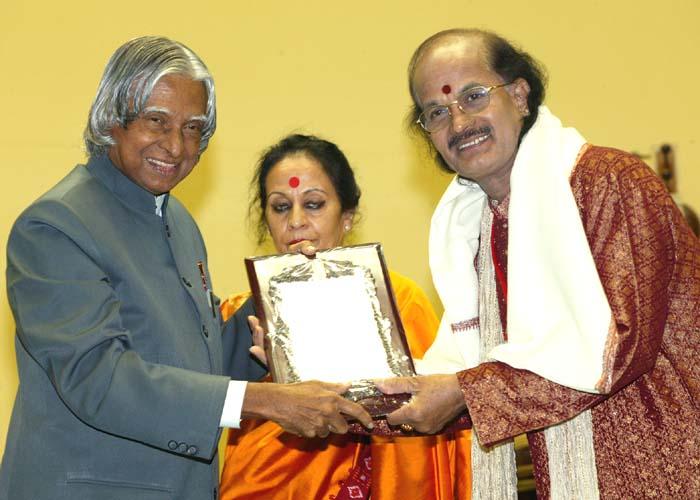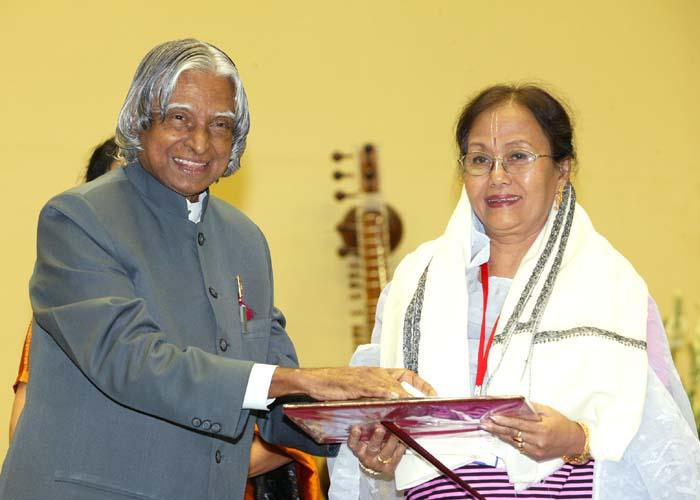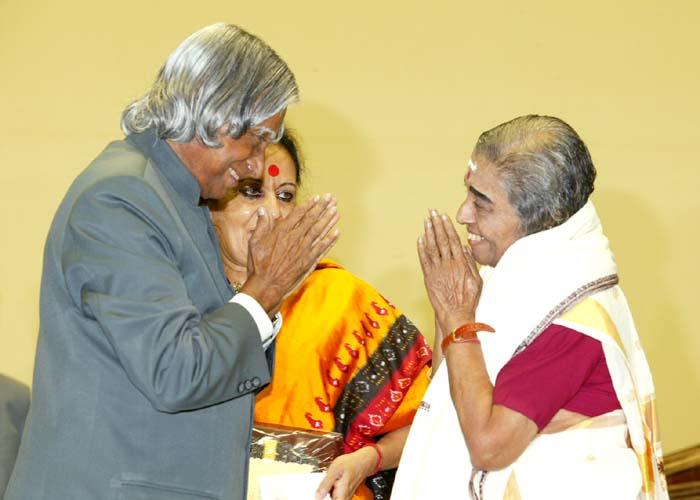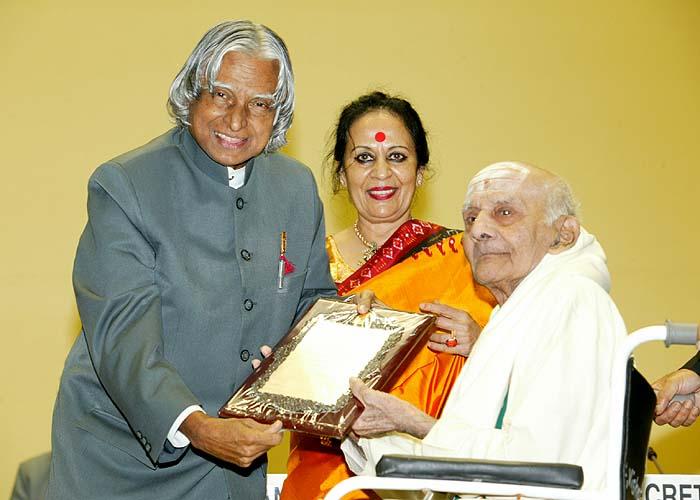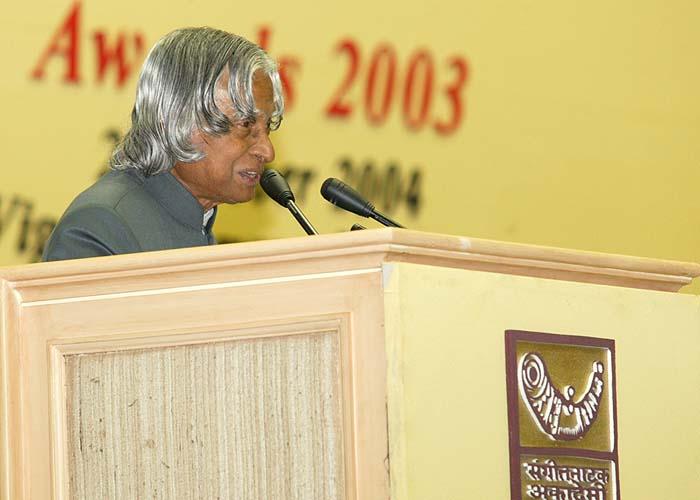Address During The Conferment Of The Sangeet Natak Akademi Awards 2003
New Delhi : 26-10-2004
Music Perfects the Human Life
I am indeed delighted to participate in the conferment of the Sangeet Natak Akademi awards for the year 2003. I greet the organizers, musicians, dancers, theatre artists, art lovers and distinguished participants. When I think of Classical music I find that any Raga has the purpose of directing the mind of the listeners towards God and his manifestations. The Sangeet Natak Akademi, which is now 52 years old, has honoured many practitioners, Gurus and scholars in the performing arts, who represent the nation?s highest achievement in Music, Dance and Drama.
Elevating the minds
In the material world, the human being is all the time busy with the day to day activities like a machine. This way of life leads to stress and ailments. In this competitive world we have no option but to follow this path. In order to overcome this phenomenon, there is a need to provide an alternative form of entertainment to the tired minds, which is what the music, the dance and the theatre artists provide. Now I remember the famous lines from Rumi?s poem:
Angel is free because of his knowledge,
The beast because of his ignorance,
Between the two remains the son of man to struggle?
How to come out of this human struggle? How to elevate the children of God to angelic state? This can be done only by performing art forms.
I indeed had the great fortune of a good friend, who taught me carnatic music. Every time I hear Purandara Dasa composition ?Bhagyada Lakshmi baramma in Madhyamavati raga, particularly when this kirtana is sung by M.S. Subbulakshmi, it is indeed heavenly. Such a great elevating musical treat. I like it.
Golden Period of South Indian Music
Some say, 15th century AD was the golden period of South Indian Music. Because, during this period, Annamacharya in Telugu and Arunagirinathar in Tamil and Purandaradasa in Kannada were contributing immensely to the cause of carnatic music in these languages. I have also heard about interesting interactions between Annamacharya and Purandara Dasa. Then comes the another epoch with Thiyagaraja Bhagavadhar providing the leadership for karnatic music.
Purandara Dasa?s life is indeed very rich in resource and intellect. It was a beautiful life. The way he gave up his material attachments and a life of wealth and opulence is revealing. He started composing poems in the year 1514 after his enlightenment. His famous first kirtana after enlightenment Mosa Hodha nallo was a landmark.
From there, he went on to compose a large number of kirtanas, all full of captivating devotional mood and liberating experience. However, only about 8000 of them are available to us today. Research is required to discover the missing compositions of Purandara Dasa for retrieving them to the humanity.
Fusion of Music
Recently when I visited South Africa I attended a cultural programme at Chatsworth. There I saw a fusion dance in which Zulu dance form, Bharatnatyam and Ballet was presented in an excellent fashion. The coordination between the artists and the rhythm of music stole the show. In the same programme, one native African Patrick sang a Carnatic music kriti in Hamsadwani raga. It was a beautiful rendering. Such fusion demonstrates the principle that music and dance do not have any borders. In Indian environment, I have seen such beautiful mingling of different art forms in fusion presented by Dr.L.Subramaniam, Raja Radha Reddy and Maestro Bismillah Khan.
Rashtrapati Bhavan Experience
To have deeper insight into our performing art culture and to pay a tribute to the India Cultural heritage we have started ?Indradhanush? which organizes cultural events in the art theatre of Rashtrapati Bhavan. The aim of Indradhanush is to acknowledge the contribution of the renowned as well as the young budding artists. So far, we have organized thirteen such programmes. In addition, we have also organized cultural programmes of young prodigies on various occasions like Childrens? day, Holi, Teachers? day etc. Though most of the programmes are held in the Art Theatre one programme was organized in the Moghal Garden Lawns on 8th November 2003 which was a full moon night, which I would like to share with you. As the moon light bathed the lawns of the Mughal garden of the Rashtrapati Bhavan, beauty was enhanced by the flute performance of Maestro Pandit Hari Prasad Chaurasia. So intrigued was Pandit Hari Prasad Chaurasia with the ambience that he was all set to transform the Moghal Gardens into Vrindavan garden with the soulful sound of his Flute. He commenced the programme with Raga Bhopali equivalent of Raga Mohanam of South Indian Carnatic Music. The performance progressed with the composition in Raga Hamsadhwani and concluded with Raga Pahari. He was accompanied by Tabla Maestro Ustad Shafat Ahmed Khan. We are going to have a similar programme in November 2004 with Maestro L. Subramanian, a famous Violinist.
The response from the invitees has been tremendous. The audience felt that it is the life time opportunity to listen to the maestros at such close quarters. They have been mentioning that it was an elevating experience to listen or witness the performance amidst their busy schedule, in the Moghal Garden environment.
Composite Culture Enriches our Tradition
Wherever I have gone in different parts of the country, I find that the rural folk and the tribal communities are nurturing the love for music and dance since ages. Many times they just need an opportunity to break into song and dance. It is here I find that our tradition and culture are being put to effective use by smoothening the rough edges of life in our countryside. Also, they are helping us in preserving, propagating and developing our cultural traditions since centuries. In fact, I might say that the evolution of our music, dance and theatre has been woven by our rural folk into the very history of our nation. It gives meaning to the life of our people. The intermingling of diverse streams which make up our composite culture has fully enriched our tradition of artistic expression and should be actively encouraged by the Sangeet Natak Akademi.
Preservation of our Cultural Heritage
I have five suggestions to make to the Sangeet Natak Akademi.
a) The country has produced a number of artists in music and dance. Many of them have made life time contribution to the art form. Some of the names which comes to my mind are Smt. M.S. Subbulakshmi, Ustad Bismillah Khan, Pandit Ravi Shankar, Pandit Birju Maharaj, Janab Ibrahim Elkazi and Smt. Yamini Krishnamurthy. I would recommend celebrations of their work by the Sangeet Natak Akademi by organizing a Musicians Meet. In this meet, the disciples of these luminaries can perform and communicate their learning experiences with these artists which can become the source of inspiration for the future generations to adopt.
b) Sangeet Natak Akademi can carry out a survey on the traditional forms of music and dance spread all over the country which are being threatened and may be lost for the nation so that appropriate timely encouragement can be provided by the Government for these forms of art.
c) Government may also consider making music and dance as a part of the regular curriculum in school education. This will enable development of holistic personality among the students and also reduce the stress of the students from career oriented educational system. This also may enhance the productivity and performance of the students in other career tasks.
d) You may also consider instituting young artist?s awards for motivating young talents towards classical art forms.
e) Classical music presentation invariably needs more than an hour for the artists to present their best. Electronic media should capture the best part of the performance of classical artists of five to ten minutes when they are performing, and propagate that for inspiring the young for nurturing our classical art form.
Conclusion
With this background, I have a dream which I am sure can take a shape with the support of this audience and institutions like Sangeet Natak Akademi. Just like Subramanya Bharatiar, Rabindranath Tagore, inspired this nation towards the freedom movement through their poetry. I would like to see the present day artists, in Bharatanatyam, Carnatic Music, Hindustani Music and Kutchipudi the poets of our nation and the theatre artists should collectively create a theme in their visualization of India achieving the second vision that is developed India. They should envision and imagine our young people living in a prosperous India, living in a safe India and living in a happy and developed India. If all of you convert this into action, the nation will be ever thankful to all the artists and the divine souls of Rabindranath Tagore and Subramanya Bharatiyar, will pour their blessings on them for transforming their vision into a reality.
Wish you all the best.
May God bless you.

